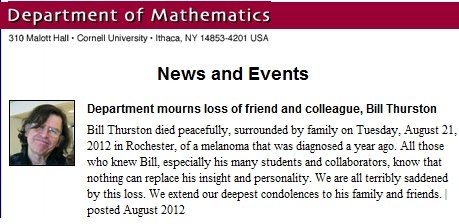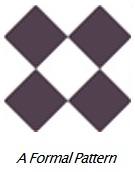See also the Thurston link in the previous post.
Saturday, January 5, 2019
Friday, August 24, 2012
Formal Pattern
(Continued from In Memoriam (Aug. 22), Chapman's Homer (Aug. 23),
and this morning's Colorful Tale)
An informative, but undated, critique of the late Marvin W. Meyer
by April D. DeConick at the website of the Society of Biblical Literature
appeared in more popular form in an earlier New York Times
op-ed piece, "Gospel Truth," dated Dec. 1, 2007.
A check, in accord with Jungian synchronicity, of this journal
on that date yields a quotation from Plato's Phaedrus —
"The soul or animate being has the care of the inanimate."
Related verses from T. S. Eliot's Four Quartets —
"The detail of the pattern is movement."
"So we moved, and they, in a formal pattern."
Some background from pure mathematics (what the late
William P. Thurston called "the theory of formal patterns")—
Monday, May 13, 2013
Pattern
"So we moved, and they, in a formal pattern"
— Four Quartets
See also yesterday's "Multi-Levels to Keep All Happy"
and past posts that mention Multispeech.
Sunday, December 9, 2012
Deep Structure
The concept of "deep structure," once a popular meme,
has long been abandoned by Chomskians.
It still applies, however, to the 1976 mathematics, diamond theory ,
underlying the formal patterns discussed in a Royal Society paper
this year.
A review of deep structure, from the Wikipedia article Cartesian linguistics—
|
[Numbers in parentheses refer to pages in the original 1966 Harper edition of Chomsky's book Cartesian Linguistics .] Deep structure vs. surface structure "Pursuing the fundamental distinction between body and mind, Cartesian linguistics characteristically assumes that language has two aspects" (32). These are namely the sound/character of a linguistic sign and its significance (32). Semantic interpretation or phonetic interpretation may not be identical in Cartesian linguistics (32). Deep structures are often only represented in the mind (a mirror of thought), as opposed to surface structures, which are not. Deep structures vary less between languages than surface structures. For instance, the transformational operations to derive surface forms of Latin and French may obscure common features of their deep structures (39). Chomsky proposes, "In many respects, it seems to me quite accurate, then, to regard the theory of transformational generative grammar, as it is developing in current work, as essentially a modern and more explicit version of the Port-Royal theory" (39). Summary of Port Royal Grammar The Port Royal Grammar is an often cited reference in Cartesian Linguistics and is considered by Chomsky to be a more than suitable example of Cartesian linguistic philosophy. "A sentence has an inner mental aspect (a deep structure that conveys its meaning) and an outer, physical aspect as a sound sequence"***** This theory of deep and surface structures, developed in Port Royal linguistics, meets the formal requirements of language theory. Chomsky describes it in modern terms as "a base system that generates deep structures and a transformational system that maps these into surface structures", essentially a form of transformational grammar akin to modern studies (42). |
The corresponding concepts from diamond theory are…
"Deep structure"— The line diagrams indicating the underlying
structure of varying patterns
"A base system that generates deep structures"—
Group actions on square arrays… for instance, on the 4×4 square
"A transformational system"— The decomposition theorem
that maps deep structure into surface structure (and vice-versa)
Monday, September 17, 2012
Pattern Conception
( Continued from yesterday's post FLT )
Context Part I —
"In 1957, George Miller initiated a research programme at Harvard University to investigate rule-learning, in situations where participants are exposed to stimuli generated by rules, but are not told about those rules. The research program was designed to understand how, given exposure to some finite subset of stimuli, a participant could 'induce' a set of rules that would allow them to recognize novel members of the broader set. The stimuli in question could be meaningless strings of letters, spoken syllables or other sounds, or structured images. Conceived broadly, the project was a seminal first attempt to understand how observers, exposed to a set of stimuli, could come up with a set of principles, patterns, rules or hypotheses that generalized over their observations. Such abstract principles, patterns, rules or hypotheses then allow the observer to recognize not just the previously seen stimuli, but a wide range of other stimuli consistent with them. Miller termed this approach 'pattern conception ' (as opposed to 'pattern perception'), because the abstract patterns in question were too abstract to be 'truly perceptual.'….
…. the 'grammatical rules' in such a system are drawn from the discipline of formal language theory (FLT)…."
— W. Tecumseh Fitch, Angela D. Friederici, and Peter Hagoort, "Pattern Perception and Computational Complexity: Introduction to the Special Issue," Phil. Trans. R. Soc. B (2012) 367, 1925-1932
Context Part II —
Context Part III —
A four-color theorem describes the mathematics of
general structures, not just symbol-strings, formed from
four kinds of things— for instance, from the four elements
of the finite Galois field GF(4), or the four bases of DNA.
Context Part IV —
A quotation from William P. Thurston, a mathematician
who died on Aug. 21, 2012—
"It may sound almost circular to say that
what mathematicians are accomplishing
is to advance human understanding of mathematics.
I will not try to resolve this
by discussing what mathematics is,
because it would take us far afield.
Mathematicians generally feel that they know
what mathematics is, but find it difficult
to give a good direct definition.
It is interesting to try. For me,
'the theory of formal patterns'
has come the closest, but to discuss this
would be a whole essay in itself."
Related material from a literate source—
"So we moved, and they, in a formal pattern"
Formal Patterns—
Not formal language theory but rather
finite projective geometry provides a graphic grammar
of abstract design—
See also, elsewhere in this journal,
Crimson Easter Egg and Formal Pattern.
Wednesday, August 22, 2012
In Memoriam
A quotation from William P. Thurston,
who died yesterday—
"It may sound almost circular to say that
what mathematicians are accomplishing
is to advance human understanding of mathematics.
I will not try to resolve this
by discussing what mathematics is,
because it would take us far afield.
Mathematicians generally feel that they know
what mathematics is, but find it difficult
to give a good direct definition.
It is interesting to try. For me,
'the theory of formal patterns'
has come the closest, but to discuss this
would be a whole essay in itself."
Related material from a literate source—
"So we moved, and they, in a formal pattern"
— and from a different source, cached shortly after midnight
on the (GMT) date of Thurston's death —
(Click for Google Cache information and to enlarge.)
Detail from the above Math Overflow discussion—
Tuesday, July 21, 2009
Tuesday July 21, 2009
Today's Readings:
-
The White Itself
Plato and the "concrete universal"-- Log24 on Thursday, July 16, 2009
-
Edged with Brown
Context for a Log24 entry of July 16: "So we moved, and they, in a formal pattern, Along the empty alley, into the box circle, To look down into the drained pool. Dry the pool, dry concrete, brown edged, And the pool was filled with water out of sunlight, And the lotos rose, quietly, quietly, The surface glittered out of heart of light...."
-
Signifying Nothing
An essay on Harvard professor Henry Louis Gates, Jr.
-
Professor Gates Arrested
A racial incident in Cambridge on Thursday, July 16, 2009
-
New England White
Race relations in Academia
-
Notes on Mathematics
and Narrative"... the glue that binds the brotherhood is ultimately made not of love and interracial harmony, but of something stronger and more enduring: shame, fear, and greed." -- Review of New England White
-
Don't Forget Hate
Cf. Eugene Burdick and The Word, 1966. More recently, Tom Wolfe and The Word and Pig and Rat Get Lost.





